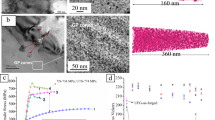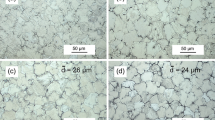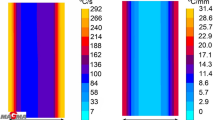Abstract
Commercially cast Mg alloys generally contain two kinds of second-phase particles with different length scales, i.e. nanoscale precipitates and microscale particles. Both have substantial effect on the strength and ductility of Mg alloys, which, however, is still insufficiently understood up to now. Here in present work, a strengthening model and micromechanics model were, respectively, developed to quantitatively describe the individual influence and coupling effect of the two second-phase particles on yield strength and ductility. The relationships between the second-phase particles (size, volume fraction, aspect ratio and orientation) and strength or ductility, were ad hoc and experimentally validated in three Mg alloys with different precipitate orientations, i.e. Mg–3Gd alloy with prismatic plate precipitates, Mg–3.5Zn alloy with [0001]α rod precipitates and Mg–1Gd–0.4Zn–0.2Zr alloy with basal plate precipitates. Comparisons indicate that the calculations are in quite good agreement with the experimental data. It was commonly revealed that the precipitate strengthening (Orowan) makes a major contribution to the strength, which is highly dependent on the precipitate shape and orientation. On the other hand, the ductility is predominantly controlled by the microscale particles, which, serving as the microvoid initiators, have a detrimental effect on ductility much greater than the nanoscale precipitates.














Similar content being viewed by others
References
Agnew SR, Nie JF (2010) Preface to the viewpoint set on: the current state of magnesium alloy science and technology. Scr Mater 63:671–673. https://doi.org/10.1016/j.scriptamat.2010.06.029
Kainer KU, Huang YD, Dieringa H, Hort N (2010) Status of the development of creep resistant magnesium materials for automotive applications. Mater Sci Forum 638–642:73–80. https://doi.org/10.4028/www.scientific.net/MSF.638-642.73
Dharmendra C, Rao KP, Prasad YVRK, Hort N, Kainer KU (2013) Hot workability analysis with processing map and texture characteristics of as-cast TX32 magnesium alloy. J Mater Sci 48:5236–5246. https://doi.org/10.1007/s10853-013-7314-9
Guo L, Fujita F (2012) Effect of equivalent strain and redundant shear strain on microstructure and texture evolution during hot rolling in Mg–3Al–1Zn alloys. J Mater Sci 47:6213–6219. https://doi.org/10.1007/s10853-012-6522-z
Huang XS, Suzuki K, Chino Y, Mabuchi M (2012) Influence of rolling temperature on static recrystallization behavior of AZ31 magnesium alloy. J Mater Sci 47:4561–4567. https://doi.org/10.1007/s10853-012-6314-5
Robson JD, Paa-Rai C (2015) The interaction of grain refinement and ageing in magnesium–zinc–zirconium (ZK) alloys. Acta Mater 95:10–19. https://doi.org/10.1016/j.actamat.2015.05.012
Mendis CL, Ohishi K, Kawamura Y, Honma T, Kamado S, Hono K (2009) Precipitation-hardenable Mg–2.4Zn–0.1Ag–0.1Ca–0.16Zr (at.%) wrought magnesium alloy. Acta Mater 57:749–760. https://doi.org/10.1016/j.actamat.2008.10.033
Dorward RC (1999) Precipitate coarsening during overaging of Al–Zn–Mg–Cu alloy. Mater Sci Technol 15:1133–1138. https://doi.org/10.1179/026708399101505176
Stanford N, Geng J, Chun YB, Davies CHJ, Nie JF, Barnett MR (2012) Effect of plate-shaped particle distributions on the deformation behaviour of magnesium alloy AZ91 in tension and compression. Acta Mater 60:218–228. https://doi.org/10.1016/j.actamat.2011.10.001
Stanford N, Barnett MR (2009) Effect of particles on the formation of deformation twins in a magnesium-based alloy. Mater Sci Eng, A 516:226–234. https://doi.org/10.1016/j.msea.2009.04.001
Bhattacharyya JJ, Wang F, Stanford N, Agnew SR (2018) Slip mode dependency of dislocation shearing and looping of precipitates in Mg alloy WE43. Acta Mater 146:55–62. https://doi.org/10.1016/j.actamat.2017.12.043
Kondori B, Benzerga AA (2017) Modeling damage accumulation to fracture in a magnesium-rare earth alloy. Acta Mater 124:225–236. https://doi.org/10.1016/j.actamat.2016.10.074
Goods SH, Brown LM (1979) Overview No. 1: the nucleation of cavities by plastic deformation. Acta Metall 27:1–15. https://doi.org/10.1016/0001-6160(79)90051-8
Liu G, Sun J, Nan CW, Chen KH (2005) Experiment and multiscale modeling of the coupled influence of constituents and precipitates on the ductile fracture of heat-treatable aluminum alloys. Acta Mater 53:3459–3468. https://doi.org/10.1016/j.actamat.2005.04.002
Liu G, Zhang GJ, Wang RH, Hu W, Sun J, Chen KH (2007) Heat treatment-modulated coupling effect of multi-scale second-phase particles on the ductile fracture of aged aluminum alloys. Acta Mater 55:273–284. https://doi.org/10.1016/j.actamat.2006.08.026
Liu G, Zhang GJ, Ding XD, Sun J, Chen KH (2004) The influences of multiscale-sized second-phase particles on ductility of aged aluminum alloys. Metall Mater Trans A 35:1725–1734. https://doi.org/10.1007/s11661-004-0081-0
Liu G, Zhang GJ, Ding XD, Sun J, Chen KH (2003) Modeling the strengthening response to aging process of heat-treatable aluminum alloys containing plate/disc- or rod/needle-shaped precipitates. Mater Sci Eng, A 344:113–124. https://doi.org/10.1016/S0921-5093(02)00398-2
Gilmore DL, Starke EA (1997) Trace element effects on precipitation processes and mechanical properties in an Al–Cu–Li alloy. Metall Mater Trans A 28:1399–1415. https://doi.org/10.1007/s11661-997-0203-6
Kelly PM, Jostsons A, Blake RG, Napier JG (1975) The determination of foil thickness by scanning transmission electron microscopy. Phys Stat Sol 31:771–780
Crompton JMG, Waghorne RM, Brook GB (1966) The estimation of size distribution and density of precipitates from electron micrographs of thin foils. Br J Appl Phys 17:1301–1305. https://doi.org/10.1088/0508-3443/17/10/307
Chen BA, Liu G, Wang RH, Zhang JY, Jiang L, Song JJ, Sun J (2013) Effect of interfacial solute segregation on ductile fracture of Al–Cu–Sc alloys. Acta Mater 61:1676–1690. https://doi.org/10.1016/j.actamat.2012.11.043
Yang C, Zhang P, Shao D, Wang RH, Cao LF, Zhang JY, Liu G, Chen BA, Sun J (2016) The influence of Sc solute partitioning on the microalloying effect and mechanical properties of Al–Cu alloys with minor Sc addition. Acta Mater 119:68–79. https://doi.org/10.1016/j.actamat.2016.08.013
Yuan SP, Liu G, Wang RH, Zhang GJ, Pu X, Sun J, Chen KH (2009) Effect of precipitate morphology evolution on the strength–toughness relationship in Al–Mg–Si alloys. Scr Mater 60:1109–1112. https://doi.org/10.1016/j.scriptamat.2009.02.047
Fu W, Wang RH, Xue H, Kuang J, Zhang JY, Liu G, Sun J (2018) Effects of Zr addition on the multiscale second-phase particles and fracture behavior for Mg–3Gd–1Zn alloy. J Alloys Compd 747:197–210. https://doi.org/10.1016/j.jallcom.2018.02.328
Fu W, Wang RH, Zhang JY, Wu K, Liu G, Sun J (2018) The effect of precipitates on voiding, twinning, and fracture behaviors in Mg alloys. Mater Sci Eng, A 720:98–109. https://doi.org/10.1016/j.msea.2018.02.039
Peng QM, Huang YD, Meng J, Li YD, Kainer KU (2011) Strain induced GdH2 precipitate in Mg–Gd based alloys. Intermetallics 19:382–389. https://doi.org/10.1016/j.intermet.2010.11.001
Gao X, Nie JF (2007) Structure and thermal stability of primary intermetallic particles in an Mg–Zn casting alloy. Scr Mater 57:655–658. https://doi.org/10.1016/j.scriptamat.2007.06.005
Nie JF (2003) Effects of precipitate shape and orientation on dispersion strengthening in magnesium alloys. Scr Mater 48:1009–1015. https://doi.org/10.1016/s1359-6462(02)00497-9
Hutchinson CR, Nie JF, Gorsse S (2005) Modeling the precipitation processes and strengthening mechanisms in a Mg–Al–(Zn) AZ91 alloy. Metall Mater Trans A 36:2093–2105. https://doi.org/10.1007/s11661-005-0330-x
Toda-Caraballo I, Galindo-Nava EI, Rivera-Díaz-del-Castillo PEJ (2014) Understanding the factors influencing yield strength on Mg alloys. Acta Mater 75:287–296. https://doi.org/10.1016/j.actamat.2014.04.064
Cáceres CH, Davidson CJ, Griffiths JR, Newton CL (2002) Effects of solidification rate and ageing on the microstructure and mechanical properties of AZ91 alloy. Mater Sci Eng, A 325:344–355. https://doi.org/10.1016/S0921-5093(01)01467-8
Hall EO (1951) The deformation and ageing of mild steel: III discussion of results. Proc Phys Soc B 64:747–753
Petch NJ (1953) The cleavage strength of polycrystals. J Iron Steel Inst 174:25–28
Caceres CH, Mann GE, Griffiths JR (2011) Grain size hardening in Mg and Mg–Zn Solid Solutions. Metall Mater Trans A 42:1950–1959. https://doi.org/10.1007/s11661-010-0599-2
Mintz B, Gunawardana WD, Su H (2008) Al as solid solution hardener in steels. Mater Sci Technol 24:596–600. https://doi.org/10.1179/174328407x248460
Nagarjuna S, Srinivas M, Balasubramanian K, Sarma DS (1996) The alloy content and grain size dependence of flow stress in Cu Ti alloys. Acta Mater 44:2285–2293. https://doi.org/10.1016/1359-6454(95)00358-4
Gao L, Chen RS, Han EH (2009) Effects of rare-earth elements Gd and Y on the solid solution strengthening of Mg alloys. J Alloys Compd 481:379–384. https://doi.org/10.1016/j.jallcom.2009.02.131
Akhtar A, Teghtsoonian E (1972) Substitutional solution hardening of magnesium single crystals. Philos Mag 25:897–916. https://doi.org/10.1080/14786437208229311
Gypen LA, Deruyttere A (1977) Multi-component solid solution hardening. J Mater Sci 12:1028–1033. https://doi.org/10.1007/BF00540987
Gypen LA, Deruyttere A (1977) Multi-component solid solution hardening. J Mater Sci 12:1034–1038. https://doi.org/10.1007/BF00540988
Roth HA, Davis CL, Thomson RC (1997) Modeling solid solution strengthening in nickel alloys. Metall Mater Trans A 28:1329–1335. https://doi.org/10.1007/s11661-997-0268-2
Li ZM, Fu PH, Peng LM, Wang YG, Jiang HY (2013) Strengthening mechanisms in solution treated Mg–yNd–zZn–xZr alloy. J Mater Sci 48:6367–6376. https://doi.org/10.1007/s10853-013-7436-0
Fleischer RL (1963) Substitutional solution hardening. Acta Metall 11:203–209. https://doi.org/10.1016/0001-6160(63)90213-X
Labusch R (1970) A statistical theory of solid solution hardening. Phys Stat Sol 41:659–669
Hutchinson WB, Barnett MR (2010) Effective values of critical resolved shear stress for slip in polycrystalline magnesium and other hcp metals. Scr Mater 63:737–740. https://doi.org/10.1016/j.scriptamat.2010.05.047
Yin DD, Wang QD, Boehlert CJ, Chen Z, Li HM, Mishra RK, Chakkedath A (2016) In-situ study of the tensile deformation and fracture modes in peak-aged cast Mg–11Y–5Gd–2Zn–0.5Zr (weight percent). Metall Mater Trans A 47:6438–6452. https://doi.org/10.1007/s11661-016-3709-y
Cepeda-Jiménez CM, Molina-Aldareguia JM, Carreño F, Pérez-Prado MT (2015) Prominent role of basal slip during high-temperature deformation of pure Mg polycrystals. Acta Mater 85:1–13. https://doi.org/10.1016/j.actamat.2014.11.013
Solomon ELS, Marquis EA (2018) Deformation behavior of β′ and β′′′ precipitates in Mg–RE alloys. Mater Lett 216:67–69. https://doi.org/10.1016/j.matlet.2017.12.149
Gerold V, Haberkorn H (1966) On the critical resolved shear stress of solid solutions containing coherent precipitates. Phys Stat Sol 16:675–684
Wang JT, Stanford N (2015) Investigation of precipitate hardening of slip and twinning in Mg–5%Zn by micropillar compression. Acta Mater 100:53–63. https://doi.org/10.1016/j.actamat.2015.08.012
Wang C, Wu G, Lavernia EJ, Ding W (2016) Influences of heat treatment on microstructural evolution and tensile behavior of squeeze-cast Mg–Gd–Y–Zr alloy. J Mater Sci 52:1831–1846. https://doi.org/10.1007/s10853-016-0473-8
Scudino S, Liu G, Sakaliyska M, Surreddi KB, Eckert J (2009) Powder metallurgy of Al-based metal matrix composites reinforced with β-Al3Mg2 intermetallic particles: analysis and modeling of mechanical properties. Acta Mater 57:4529–4538. https://doi.org/10.1016/j.actamat.2009.06.017
Nardone VC, Prewo KM (1986) On the strength of discontinuous silicon carbide reinforced aluminum composites. Scr Metall 20:43–48. https://doi.org/10.1016/0036-9748(86)90210-3
Cheng PM, Zhang GJ, Zhang JY, Liu G, Sun J (2015) Coupling effect of intergranular and intragranular particles on ductile fracture of Mo–La2O3 alloys. Mater Sci Eng, A 640:320–329. https://doi.org/10.1016/j.msea.2015.05.032
Yuan GY, Sun YS, Ding WJ (2001) Effects of bismuth and antimony additions on the microstructure and mechanical properties of AZ91 magnesium alloy. Mater Sci Eng, A 308:38–44. https://doi.org/10.1016/S0921-5093(00)02043-8
Yang MB, Pan FS, Cheng RJ, Shen J (2008) Comparison about effects of Sb, Sn and Sr on as-cast microstructure and mechanical properties of AZ61–0.7Si magnesium alloy. Mater Sci Eng, A 489:413–418. https://doi.org/10.1016/j.msea.2008.03.021
Khan SA, Bhuiyan MS, Miyashita Y, Mutoh Y, Koike T (2011) Corrosion fatigue behavior of die-cast and shot-blasted AM60 magnesium alloy. Mater Sci Eng, A 528:1961–1966. https://doi.org/10.1016/j.msea.2010.11.033
Nie JF (2012) Precipitation and hardening in magnesium alloys. Metall Mater Trans A 43:3891–3939. https://doi.org/10.1007/s11661-012-1217-2
Nie JF, Gao X, Zhu SM (2005) Enhanced age hardening response and creep resistance of Mg–Gd alloys containing Zn. Scr Mater 53:1049–1053. https://doi.org/10.1016/j.scriptamat.2005.07.004
Bettles CJ, Gibson MA, Venkatesan K (2004) Enhanced age-hardening behaviour in Mg–4 wt% Zn micro-alloyed with Ca. Scr Mater 51:193–197. https://doi.org/10.1016/j.scriptamat.2004.04.020
He SM, Peng LM, Zeng XQ, Ding WJ, Zhu YP (2006) Comparison of the microstructure and mechanical properties of a ZK60 alloy with and without 1.3wt.% gadolinium addition. Mater Sci Eng, A 433:175–181. https://doi.org/10.1016/j.msea.2006.06.063
He SM, Zeng XQ, Peng LM, Gao X, Nie JF, Ding WJ (2007) Microstructure and strengthening mechanism of high strength Mg–10Gd–2Y–0.5Zr alloy. J Alloys Compd 427:316–323. https://doi.org/10.1016/j.jallcom.2006.03.015
Wang LD, Xing CY, Hou XL, Wu YM, Sun JF, Wang LM (2010) Microstructures and mechanical properties of as-cast Mg–5Y–3Nd–Zr–xGd (x = 0, 2 and 4 wt%) alloys. Mater Sci Eng, A 527:1891–1895. https://doi.org/10.1016/j.msea.2009.11.026
Li DQ, Wang QD, Ding WJ (2006) Characterization of phases in Mg–4Y–4Sm–0.5Zr alloy processed by heat treatment. Mater Sci Eng, A 428:295–300. https://doi.org/10.1016/j.msea.2006.05.011
Jafari Nodooshan HR, Wu GH, Liu WC, Wei GL, Li YL, Zhang S (2016) Effect of Gd content on high temperature mechanical properties of Mg–Gd–Y–Zr alloy. Mater Sci Eng, A 651:840–847. https://doi.org/10.1016/j.msea.2015.11.047
Lu JW, Yin DD, Ren LB, Quan GF (2016) Tensile and compressive deformation behavior of peak-aged cast Mg–11Y–5Gd–2Zn–0.5Zr (wt%) alloy at elevated temperatures. J Mater Sci 51:10464–10477. https://doi.org/10.1007/s10853-016-0266-0
Chan KS (1995) A fracture model for hydride-induced embrittlement. Acta Metall Mater 43:4325–4335. https://doi.org/10.1016/0956-7151(95)00133-G
Hahn GT, Rosenfield AR (1975) Metallurgical factors affecting fracture toughness of aluminum alloys. Metall Trans A 6:653–668. https://doi.org/10.1007/BF02672285
Van Stone RH, Cox TB, Low JR, Psioda JA (1985) Microstructural aspects of fracture by dimpled rupture. Int Metals Rev 30:157–180. https://doi.org/10.1179/imtr.1985.30.1.157
Barnett M, Setty M, Siska F (2012) Estimating critical stresses required for twin growth in a magnesium alloy. Metall Mater Trans A 44:2962–2969. https://doi.org/10.1007/s11661-012-1573-y
Muránsky O, Barnett MR, Carr DG, Vogel SC, Oliver EC (2010) Investigation of deformation twinning in a fine-grained and coarse-grained ZM20 Mg alloy: combined in situ neutron diffraction and acoustic emission. Acta Mater 58:1503–1517. https://doi.org/10.1016/j.actamat.2009.10.057
Kadiri HE, Barrett CD, Wang J, Tomé CN (2015) Why are \( {\text{\{ 10}}\bar{1} 2 {\text{\} }} \) twins profuse in magnesium? Acta Mater 85: 354–361. https://doi.org/10.1016/j.actamat.2014.11.033
Urreta SE, Louchet F, Ghilarducci A (2001) Fracture behaviour of an Al–Mg–Si industrial alloy. Mater Sci Eng, A 302:300–307. https://doi.org/10.1016/S0921-5093(00)01706-8
Acknowledgements
This work was supported by the National Natural Science Foundation of China (Grant Nos. 51621063, 51625103, 51790482, 51761135031, 51722104, 51790484 and 51571157), the 111 Project of China (B06025) and the National Key Research and Development Program of China (2017YFB0702301). This work is also supported by the International Joint Laboratory for Micro/Nano Manufacturing and Measurement Technologies. JYZ is grateful for the Fok Ying-Tong Education Foundation (161096), China Postdoctoral Science Foundation (2016M590940, 2017T100744) and Shaanxi Province Postdoctoral Scientific Research Projects for part of financial support (2016BSHEDZZ09). KW thanks the support from the China Postdoctoral Science Foundation (2016M602811). We thank Prof. S. W. Guo (Xi’an Jiaotong University) for her help in TEM technique.
Author information
Authors and Affiliations
Corresponding authors
Ethics declarations
Conflict of interest
The authors declare that they have no conflict of interest.
Rights and permissions
About this article
Cite this article
Fu, W., Wang, R., Wu, K. et al. The influences of multiscale second-phase particles on strength and ductility of cast Mg alloys. J Mater Sci 54, 2628–2647 (2019). https://doi.org/10.1007/s10853-018-2980-2
Received:
Accepted:
Published:
Issue Date:
DOI: https://doi.org/10.1007/s10853-018-2980-2




